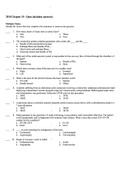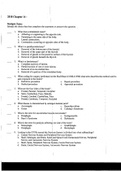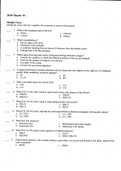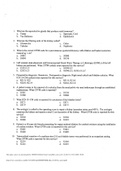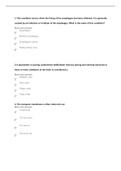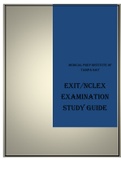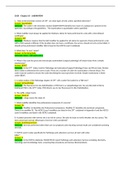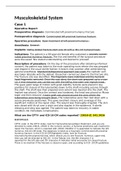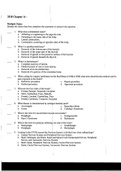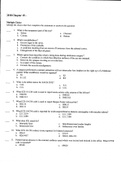University Of San Francisco
Latest uploads at University Of San Francisco. Looking for notes at University Of San Francisco? We have lots of notes, study guides and study notes available for your school.
-
249
- 0
-
15
All courses for University Of San Francisco
Latest notes & summaries University Of San Francisco
1. How many layers of tissue does an artery have? a. One c. Three b. Two d. Four 2. The conduction system contains pacemaker cells, nodes, the and the . a. Bundle of His and electrical system b. Purkinje fibers and bundle of His | c. Heart valves and purkinje fibers ' d. Electrical system and bundle of His i 3. What part of the cardiovascular systerh is responsible for the one-way flow of blood through the chambers of the heart? a. Septum c. Bundle of His b. Heart valves d. Atria 4...
1. What does contralateral mean? a. Affecting or originating in the opposite side. b. Pertaining to the same side of the body. c. Lateral contractions. d. Contractions occurring on opposite sides of the body. i 2. What is a parathyroidectomy? a. Removal of the bottom part of the thyroid. b. Removal of the upper part of the thyroid. c. Removal of glands on the posterior surface of the thyroid. d. Removal of glands beneath the thyroid. I 3. What is a laminotomy? a. Complete excision of...
Chapter 15 - EYES - to complete
1. What are the reproductive glands that produce male hormones? a. Testes c. Spermatic Cord b. Vas Deferens d. Epididymis 2. What are the filtering units of the kidney called? a. Glomerulus c. Calyx b. Tubules d. Nephrons 3. What is the correct CPT® code for a percutaneous pyelostolithotomy with dilation and basket extraction measuring 1 cm? a. 50081 c. 50080 b. 50040 d. 50130 4. Left ureteral stent placement and Extracorporeal Shock Wave Therapy or Lithotripsy (ESWL) of the left kid...
1-This condition occurs when the lining of the esophagus becomes inflamed. It is generally caused by an infection or irritation of the esophagus. What is the name of this condition? Mark one answer: Esophagitis Barrett's Esophagus Esophageal Varices Mallory-Weiss Tear 2-A pacemaker or pacing cardioverter-defibrillator that has pacing and sensing functions in three or more chambers of the heart is considered a: Mark one answer: Multiple Lead Dual Lead Single Lead Triple Lead 3. The...
Priorty Definition Deciding which needs or problems require immediate action and which ones could be delayed until later time because they are not urgent Guidelines for prioritizing Nurse and client rank client’s needs Priorities are classified as high, intermediate, or low High priorities include life-threatening needs Nonemergency and non–life-threatening needs are intermediate Client needs not directly related to client’s illness or prognosis are low priorit...
Chapter 18 – LABORATORY 1. Tests in the Chemistry section of CPT® are what types of tests unless specified otherwise? Answer: Quantitative Rationale: The codes in the Chemistry section (82009-84999) identify how much of a substance is present in the specimen. According to the guidelines, “The examination is quantitative unless specified.” 2. What modifier must always be applied to Medicare claims for tests performed in a site with a CLIA Waived certificate? Answers: QW Rationale: ...
Musculoskeletal System Case 1 Operative Report Preoperative diagnosis: Comminuted left proximal humerus fracture Postoperative diagnosis: Comminuted left proximal humerus fracture Operative procedure: Open treatment of left proximal humerus. Anesthesia: General. Implants: DePuy Global fracture stem size 10 with a 48 x 15 humeral head. Indications: The patient is a 66-year-old female who sustained a severely comminuted proximal humerus fracture. The risk and benefits of the surgical proce...
1. What does contralateral mean? a. Affecting or originating in the opposite side. b. Pertaining to the same side of the body. c. Lateral contractions. d. Contractions occurring on opposite sides of the body. i 2. What is a parathyroidectomy? a. Removal of the bottom part of the thyroid. b. Removal of the upper part of the thyroid. c. Removal of glands on the posterior surface of the thyroid. d. Removal of glands beneath the thyroid. I 3. What is a laminotomy? a. Complete excision of...
Chapter 15 - EYES - to complete

